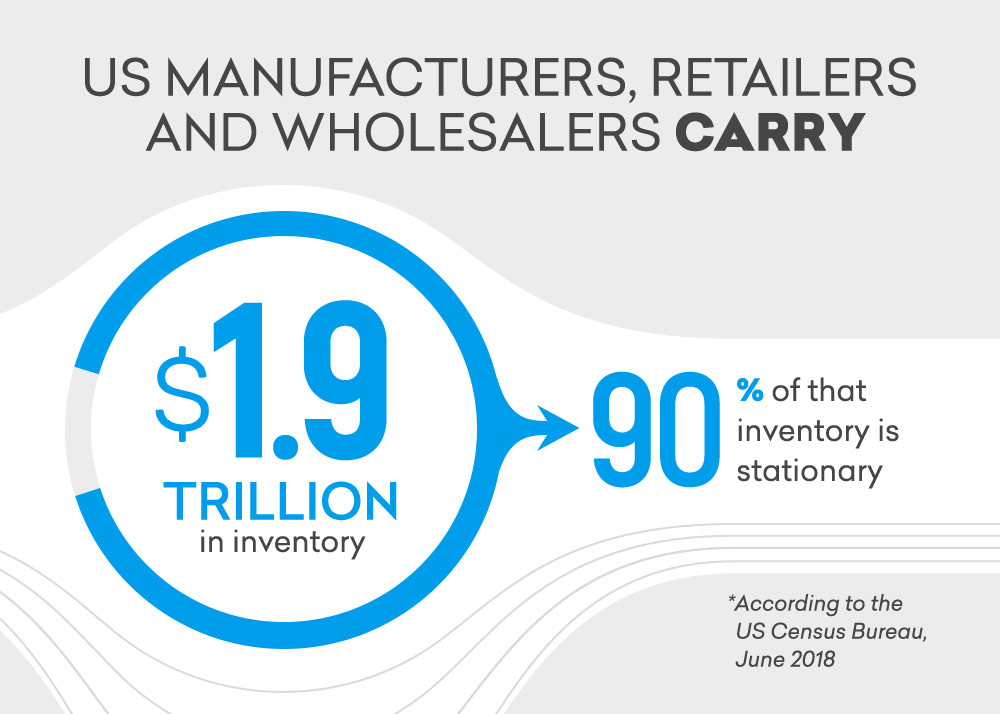Physical Address
304 North Cardinal St.
Dorchester Center, MA 02124

There’s an old business axiom that says, “Nothing happens until somebody sells something.” With inventory management, that could be changed to “Nothing happens until somebody counts something.”
Inventory can be anything from boxes of ice cream cones in the storeroom at a sweet shop to a million-square-foot warehouse full of goods for a big box chain. But in either case, accurate inventory management is a key to that company’s success.
Simply put, inventory is the goods that a business owns that it plans to sell. If your company is an apparel retailer, products become inventory when you take possession of shirts, dresses, suits and accessories from your suppliers. Those products leave the stock when they’re sold to customers. Inventory can be stored on premises or at warehouses, distribution centers and other facilities.

In the United States, manufacturers, retailers and merchant wholesalers carried more than $1.9 trillion in inventory in June 2018, according to the U.S. Census Bureau. And believe it or not, experts say that about 90 percent of a company’s inventory is stationary; it’s stored somewhere, whether on the shelves of a retail store or racks in a warehouse. Only about 10 percent of a company’s inventory is actually in transit.
Inventory is considered an asset, and as such is recorded on a company’s balance sheet. Developing an accurate valuation for the balance sheet requires either a physical inventory count to determine the quantities on hand or an ongoing inventory system that creates an accurate record of each inventory-related transaction.
Tracking inventory well is not only good business; it’s also a requirement for compliance with SEC regulations and the Sarbanes-Oxley Act (SOX) for public companies. Companies must demonstrate well-documented, well-understood and well-controlled supply chain processes as part of their compliance efforts. Warehouse Anywhere provides the tools to properly account for inventory and inventory transactions from shipping to point of use.
Complying with SOX has helped push companies into better inventory management practices. After all, losing track of inventory is the same as losing money. If you don’t know how much stock you have or where it’s located, you don’t really have it. Even goods in transit are considered inventory, although they are not typically counted as inventory for financial purposes.
With the investment that companies make in creating, storing and transporting products, inventory management is a critical factor in a company’s financial success.
Basically, inventory management is the system used to organize and track all of the company’s goods during the time the company owns them. Once they’re sold, inventory is converted to revenue.
In some industries, inventory management is also known as stock management. This is common in the retail sector for example, where apparel or home goods inventory is considered “stock on hand.”
No matter the size of a business, from a small neighborhood gift shop to a multinational corporation, effective inventory management can make the difference between failure and success. Even a basic inventory management system can ensure that appropriate levels of products are kept on hand to serve customers without tying up capital in an unproductive fashion.
Unfortunately, few rules of thumb can be applied across industry sectors. For companies with long production lead times for big-ticket items, carrying inventory makes sense, so customers aren’t disappointed. Other industries operate on a just-in-time basis to reduce inventory-carrying costs.
With a baseline understanding, the next step is to consider the different types of inventory management systems to understand which one might work best for your business.

Every business uses at least some level of inventory management system. The best inventory management systems will not only keep count of products but also provide actionable business intelligence such as identifying low and high performing products and sending re-order notifications when stocks are low.
An inventory management system helps tackle the challenge of assuring the right level of inventory is in the right place at the right time. The explosion of e-commerce, omnichannel fulfillment and expanding relationships with national and global trading partners have created new challenges to accurately managing inventory.
The spectrum of inventory management techniques ranges from the fully analog manual paper ledger that’s been used for hundreds of years all the way to the latest smart system that tracks products autonomously. There are still a surprising number of larger companies that manage inventory through an ad hoc collection of spreadsheets and legacy applications that simply don’t communicate with each other.
The inventory management process can be based on a variety of formats and technologies. We’ll explore some of the common options and discuss the pros and cons of each type.
Choosing which of these strategies to follow will set parameters for your entire approach, from infrastructure to technology. Full inventory counts are completed on a regular basis, often annually as part of a financial audit. You’ll see a retail store is conducting an audit when items on shelves are tagged with slips of paper, and some display items like furniture are tagged “Do Not Inventory.” An inventory team from a vendor is counting items when the store is closed. The same process occurs in a warehouse. This process is time and labor intensive and only provides a snapshot of the inventory.
By contrast, cycle counting is used to count only a portion of inventory on a regular basis. In a retail store, one area is counted on a particular day of the week or month, and the next day the team counts stock in a different area. In a large warehouse, the most active or most valuable items could be counted more frequently. Smaller, more frequent counts can provide better insights into the state of the inventory. However, inaccuracies can occur as well, especially if the same product is stored in multiple locations.
Of course, human error can creep into both of these processes, with inaccurate data causing a problem across the company. Both processes can be completed manually or aided by using inventory management technology.
Depending on the size and scope of your inventory problem the manual approach may be the most efficient. It may make sense to hire a vendor or complete it with internal resources. Many small businesses close a day or two per year for inventory.
Each manual step is rife with possibilities for human error, from counting on the warehouse floor to data entry to manipulating the data. Each mistake-filled action can exacerbate the problem, and only a manual re-do could restore any sense of accuracy.
One of the big negatives to manual counting is the difficulties in turning paper-based information into useful data. Making marks on a checklist is one thing — typing those results into a spreadsheet can be a daunting task.
This system uses the familiar label of black stripes that are already affixed to the product, packaging or pallet. Wearable barcode readers can speed up this process, allowing workers to shave scanning time a few seconds per item. One of the main advantages of the bar code system is the data is input in a useful digital format at the same time, so the count is more real-time. With the accuracy they get with barcodes, managers have more confidence to make purchasing and sales decisions based on the inventory levels.
Radio frequency identification tags are found in two configurations: active and passive. Active systems use tag readers located throughout a warehouse. Active systems provide real-time updates of inventory count and location. An active tag simply means it is battery operated and is used when more signal strength is required to communicate with a reader.
Passive systems are read-only when someone activates the readers, such as hand-held devices rather than fixed readers. In either case, when the tag is read, the inventory is automatically recorded in the system. Passive technology can be read at up to 40 feet, while active readers are effective up to 300 feet.
Fixed readers can run continuously, like the Warehouse Anywhere RFID scanner chandeliers in our storage locations. In this case, passive tags are read continuously.
The next level of warehouse inventory systems will be optical systems mounted on autonomous ground-based or aerial platforms. These systems use machine learning to read existing labels without barcodes or RFID and maintain an up-to-the-minute inventory.

While inventory management and warehouse management might seem like interchangeable terms, they are not.
A warehouse management system (WMS) supports the entire operation of a warehouse, which includes inventory management. Simply put, warehouse management is the umbrella term for all that occurs in a warehouse, of which inventory is one process.
A WMS will include inventory management, providing visibility into an organization’s inventory in any location. The WMS can also manage the entire supply chain operation and is often integrated with a Transportation Management System (TMS).
To some extent, the difference between warehouse management and inventory management is a matter of degree or scope. Warehouse management systems are typically used by large enterprises with at least one large warehouse or distribution center, if not multiple locations. Inventory management systems are favored by enterprises that don’t need all the functions that a full-featured WMS can provide, at least not for every warehouse location.
For example, companies engaged in large-scale e-commerce use WMS to manage inventory across their locations. A WMS can support e-commerce websites, such as showing the available quantity of each item.
To fulfill an e-commerce order, the system knows the amount of product in each warehouse and which warehouse would be the best to satisfy that order due to geographic location, shipping cost or other consideration. When the item is shipped, the WMS updates the quantity count that’s visible to all locations.
Typically a WMS will integrate with the organization’s ERP and TMS for seamless integration of information flows. By comparison, inventory management software is typically a less complex system that is ideal for individual warehouses or other storage locations that don’t need all the functionality of a full WMS.
Inventory management software will support anywhere from one to hundreds of locations to manage supply chain and fulfillment operation. The system tracks shipping and receiving, product locations and provides record keeping for up-to-the-minute visibility.
The inventory management system fully supports technology such as barcodes and RFID but doesn’t have the same comprehensive functions of the WMS. It’s also a more cost- efficient solution for many warehouse operations.
In addition to supporting retail and e-commerce operations, inventory management software is ideal for field service or healthcare operations that pre-position items for use by technicians and customers. The choice of solutions is best guided by the size and needs of the individual warehouse or storage location.
For new business owners, the following calculations might seem daunting, but don’t let that deter you. These formulas are essential for keeping stock levels optimised. Let’s explore:

EOQ = √(2DK/H)
It’s important to buy the right amount of inventory stock – neither too little, nor too much. You use the EOQ formula to determine the optimal order quantity – one that minimises the costs of ordering, receiving and holding inventory.
Where:

DIO = (Average inventory/COGS) × Days in period
The Days Inventory Outstanding formula goes a step further than the inventory turnover ratio by putting the figure into a daily context and providing a more accurate picture of a company’s inventory management and overall efficiency. Generally a low DIO is preferred but to make sense of it, you need to take into account the industry and market dynamics.
Where:

Safety stock = (Maximum daily usage × Maximum lead time in days) – (Average daily usage × Average lead time in days)
Knowing how much buffer stock to hold will help your business navigate safely through demand and lead time fluctuations. It might seem daunting but all you need to know are your purchase and sales orders history.

Reorder point = (Average daily usage x Average lead time in days) + Safety stock
You use the reorder point calculation to determine when to reorder stock. Small business owners often rely on intuition and past experience to know when to place another order, but as the business grows, this quickly becomes unsustainable.
Knowing your inventory costs helps you make smarter decisions. There are three broad categories of inventory costs: ordering costs, carrying costs, and shortage costs.
This is the expense incurred in creating and processing an order to a supplier. You’d use this to determine the EOQ of your inventory. Examples of ordering costs are:
Carrying costs are the expenses related to storing unsold goods. This includes the tangible costs such as storage, handling, and insuring, as well as intangible costs such as depreciation, the cost of deterioration and obsolescence and opportunity costs. Carrying costs will generally comprise 20% to 30% of a business’ total inventory costs.
Also known as stock out costs, this is the expense that arises from an out-of-stock situation. This can include measurable costs such as the cost of expedited shipping, buying last minute from another supplier, or loss of the margin on incomplete sales. These also include costs that are hard to quantify such as loss of customer confidence or loss of customers, idle employees and loss in goodwill.
Inventory management strategies and methods will vary based on the organization. After all, we wouldn’t expect a mom-and-pop candle shop in a resort town to keep track of goods like an automotive manufacturer. However, even that quaint candle shop uses a strategy, even if the owners may not realize it.
Here’s a look at some of the methods used by organizations of various sizes.

ABC Method: This system ranks inventory based on turnover rates. For example, the 20 percent of products that generate 80 percent of the revenue are designated Category A. Categories B and C are lower performing products. Class A products should be located closest to the fulfillment and shipping areas of the warehouse. Ongoing analysis will identify when products should shift categories and be moved to another class.
Two Bin Method: Items are stored in two locations or bins, depending on their size. When the first bin is empty, items are moved from the second bin. The stock is replenished when the second bin is empty.
Fixed Order Quantity: A minimum number of products is set, and when the inventory reaches that number a fixed number of products are ordered to restock.
Fixed Period Ordering: Goods are ordered according to a set period of time. This approach is common for small stores without sophisticated systems.
Vendor Managed Inventory: The supplier manages inventory levels and reorders based on sales or on a regular time period. This is common in grocery, retail and forward- deployed inventory for field service and healthcare.
Regardless of which inventory management method you choose, you can localize your inventory in hundreds of U.S. cities with Warehouse Anywhere’s unique inventory management capabilities. Our decentralized warehouse strategy moves your products closer to where they’re needed by joining supplier-managed inventory with supply chain technology.
With a decentralized warehouse strategy, retailers can restock popular items within hours instead of days. Field service operations can move parts closer to their customer base to improve service level agreement performance. Technicians don’t have to function as warehouse workers, allowing them to concentrate on service. Healthcare and medical device companies can preposition products for fast response and easy restocking.
Warehouse Anywhere employs advanced RFID technology and proprietary continuous scanning software to automate inventory tracking. The system fully integrates with internal inventory and ERP systems. The Warehouse Anywhere Mobile app allows field personnel to search for an item and directs them to the closest location. The app also securely manages access to the warehouse.